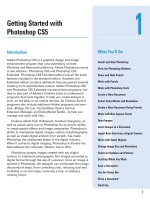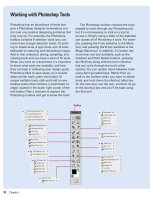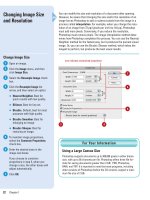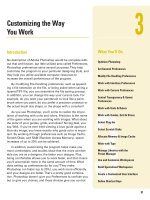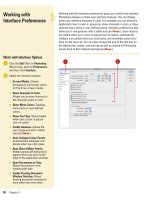Photoshop cs5 by steve Johnson part 76 docx
Bạn đang xem bản rút gọn của tài liệu. Xem và tải ngay bản đầy đủ của tài liệu tại đây (572.84 KB, 6 trang )
ptg
484 Chapter 20
Opening Video Files and Image Sequences
In Photoshop Extended, you can open video
files and image sequences using the Open
command from the File menu in the formats
listed in the table below. Video layers can con-
tain files with the following color modes and
bits per channel (bpc):
◆
Grayscale
. 8, 16, or 32 bpc
◆
RGB
. 8, 16, or 32 bpc
◆
CMYK
. 8 or 16 bpc
◆
Lab
. 8 or 16 bpc
Format Usage
MPEG-1 Uses the Moving Picture Experts Group (MPEG) format; a video format with quality slightly
below the quality of conventional VCR videos.
MPEG-4 Uses the Moving Picture Experts Group (MPEG) format; a video format that transmits over a
narrower bandwidth and can mix video with text, graphics and 2-D and 3-D animation layers.
MOV Uses the QuickTime (MOV) format; a video and animation format developed by Apple Inc.
AVI Uses the Audio Video Interleave (AVI) format; a video format developed by Microsoft for
storing video and audio information.
FLV Uses the Adobe Flash Video (FLV) format from QuickTime; supported with Flash 8 installed.
MPEG-2 Uses the Moving Picture Experts Group (MPEG) format; a video format with quality equal to
TV standards, including NTSC, and even HDTV; supported with an MPEG-2 encoder installed.
BMP Uses the Bitmap format; an image format.
Dicom Uses the DICOM (Digital Imaging and Communications in Medicine) format; an image format
used for the transfer and storage of medical images, such as ultrasounds.
JPEG Uses the JPEG (Joint Photographic Experts Group) format; an image format that uses
a compression method to reduce the size of image files primarily for the Web.
OpenEXR Uses the HDR (High Dynamic Range) format; a film format used to produce images for use
in motion picture production.
PNG Uses the PNG (Portable Network Graphics) format; an image format used to save images
for the Web. Supports up to 16 million colors and 256 levels of transparency.
PSD Uses the PSD (Photoshop) format, which saves layers, channels, notes, and color profiles.
Targa Uses the Targa format; an image format for high-end image editing on the Windows platform.
TIFF Uses a TIFF (Tagged-Image File Format) format; an image format commonly used for
printing and saving flattened images without losing quality.
Cineon Uses the Cineon Digital Film System format; a digital format developed by Kodak. Supported
with the plug-in installed.
JPEG 2000 Uses an advanced JPEG format; an image format that produces images with better
compression and quality for use on the Web or in print; supported with the plug-in installed.
Video and Image Sequence Formats
From the Library of Wow! eBook
ptg
Chapter 20 Extending Photoshop 485
If you want to add video to a document, you can create a new video
layer in Photoshop Extended. You can create a video layer from a file,
or create a blank one and add a video file to it later. If you want to open
a video later, you can use the Open command from the File menu.
Photoshop opens a variety of video files and image sequences. You can
even play the video with sound by either clicking Alt (Win) or Option
(Mac) when you hit the Play button, or toggle the sound icon on the
bottom of the panel.
Creating a Video
Layer
Create a Video Layer
Open a document.
Select the Animation panel.
◆ Click the Window menu, and
then click Animation.
To sw it ch to Tim eli ne view, cl ic k
the Convert to Timeline Animation
button.
Click the Layer menu, point to
Video Layers, and then click the
layer type you want:
◆ From File. Click New Video
Layer from File, select a video
or image sequence, and then
click Open.
◆ Blank. Click New Blank Video
Layer.
If you want to open a video file
and add it to a layer, click the File
menu, click Open, select the video
file you want to open, and then
click Open.
5
4
3
2
1
New video layer
Did You Know?
You can create a still frame from a
video layer.
If you want a still image
from a video, you can rasterize the
video layer, creating a flattened com-
posite of the current frame. Select the
video layer you want, move the play-
back head to the frame you want, click
the Layer menu, point to Rasterize, and
then click Video or Layer.
3
2
Video on the video layer
From the Library of Wow! eBook
ptg
486 Chapter 20
After you insert a video layer, you can modify it in Photoshop Extended
using the Animation panel in Timeline view. You can zoom in and out to
display the Timeline the way you want, and then drag the playhead,
also known as the current-time indicator, to the time or frame number
in the video where you want to start your modifications. You can
change the start and stop points (also known as In and Out points), trim
frames, add a fade-in or fade-out, or add animation using keyframes. A
keyframe defines the location of a property change to the video layer.
When you set at least two keyframes that change properties, such as
position, opacity, or style, you create animation.
Modifying a Video
Layer
Modify a Video Layer Duration
Open a document with a video.
Select the Animation panel.
◆ Click the Window menu, and
then click Animation.
To sw it ch to Tim eli ne view, cl ic k
the Convert to Timeline Animation
button.
Use any of the following methods
to change the duration of the
video:
◆ Start and End Work Area. Point
to the ends of the work area
bar, and then drag to change
the position.
◆ In and Out Points. Point to the
beginning or end of the layer
duration bar (cursor changes to
a double-arrow), and then drag
to change the points.
◆ Move duration. Point to the
duration bar, and then drag to
move the duration to start and
stop at a new position.
4
3
2
1
Start work area
Video layer in timeline
In point (resizing)
3
Did You Know?
You can delete a section of video.
In
the Animation panel in Timeline view,
drag the ends of the work area bar to
select the footage you want to delete,
click the Animation Options button, and
then click Lift Work Area.
2
From the Library of Wow! eBook
ptg
Chapter 20 Extending Photoshop 487
Use Keyframes to Animate Layer
Properties
Open a document.
Select the Animation panel.
◆ Click the Window menu, and
then click Animation.
To sw it ch to Tim eli ne view, cl ic k
the Convert to Timeline Animation
button.
Click the down arrow for a video
layer to display layer properties.
Click the Time-Vary Stopwatch
icon to enable shape animation for
the layer property.
Position the playhead where you
want to set a keyframe, and then
make the property changes you
want, such as Opacity, in the
Layers panel.
Use any of the following methods
to change the keyframe:
◆ Select. Click the keyframe icon.
◆ Move. Drag to change the
position.
◆ Delete. Right-click the
keyframe icon, and then click
Delete Keyframes.
◆ Method. The diamond keyframe
icon animates the property
change evenly over time
(known as a Linear Keyframe).
If you want an instant property
change, you can change the
interpolation method to a Hold
Keyframe, which appears as a
square keyframe icon. Right-
click a keyframe icon, and then
click Hold Interpolation or
Linear Interpolation.
7
6
5
4
3
2
1
4
Playhead
3
5
Linear
6
Changing the Video Playback Speed
If you want to speed up or slow down a video, you need to adjust the
frames per second (fps). To change the fps, display the video in the
Animation panel in Timeline view, click the Animation Options button,
click Document Settings, set the frames per second (fps) you want
(the higher the number, the faster the speed), and then click OK.
For Your Information
2
From the Library of Wow! eBook
ptg
488 Chapter 20
In addition to modifying a video layer, you can split it into two new
video layers at the specific point you want in Photoshop Extended. You
can zoom in and out to display the Timeline the way you want, and then
drag the playhead to the time or frame number in the video where you
want to split it. The video layer is duplicated and appears above the
original in the Animation panel. The original layer contains the video
from the start to the current time or frame, and the duplicate layer con-
tains the video from current time or frame to the end.
Splitting a Video
Layer
Split a Video Layer
Open a document with a video
layer.
Select the Animation panel.
◆ Click the Window menu, and
then click Animation.
To sw it ch to Tim eli ne view, cl ic k
the Convert to Timeline Animation
button.
Drag the playhead to the time or
frame number where you want to
split the video layer.
Click the Animation Options
button, and then click Split Layers.
5
4
3
2
1
54
3
Split video
Did You Know?
You can preview video or timeline ani-
mation.
You can preview a video or
animation in the document window.
Drag the playback head to the point
where you want to play the video or
animation. Click the Play button at the
bottom of the Animation panel. You can
also press the Spacebar to play or stop
the playback. Photoshop caches it to
memory for faster playback.
2
From the Library of Wow! eBook
ptg
Chapter 20 Extending Photoshop 489
If you have video or animation frames that you want to retouch or dupli-
cate, you can use the Clone Stamp and Healing Brush tool in
Photoshop Extended. The Clone Stamp tool allows you to sample con-
tent from one area of a frame (known as the source) and paint it over
another area of the same or a different frame (known as the target).
The Healing Brush tool allows you to blend the sampled content from
the source with the target to fix a problem. You can use the Clone
Source panel to set several samples from one part of a video frame and
clone or blend them in another video frame.
Cloning Video Layer
Content
Clone Parts of a Video Layer
Open a document with a video
layer, and then select it in the
Layers panel.
Select the Animation panel.
◆ Click the Window menu, and
then click Animation.
To sw it ch to Tim eli ne view, cl ic k the
Convert to Timeline Animation
button.
Drag the playhead to the time or
frame number that is the source of
the sample you want.
Select the Clone Stamp tool on the
toolbox.
To se t a sa mpl e po int , Al t (Wi n) or
Option (Mac), and click where you
want the sample.
To se t an oth er samp le p oin t, select
a Clone Stamp button on the Clone
Source panel, adjust the playhead,
and then repeat Step 6.
Select the target video layer and
move the playhead to the frame you
want to paint.
If you set multiple samples, click
the source in the Clone Source
panel.
TIMESAVER
Use Shift+Alt
(Win) or Shift+Option (Mac) to
show the clone overlay temporarily.
Drag the area you want to paint.
10
9
8
7
6
5
4
3
2
1
10
3
4
2
5
7
From the Library of Wow! eBook
